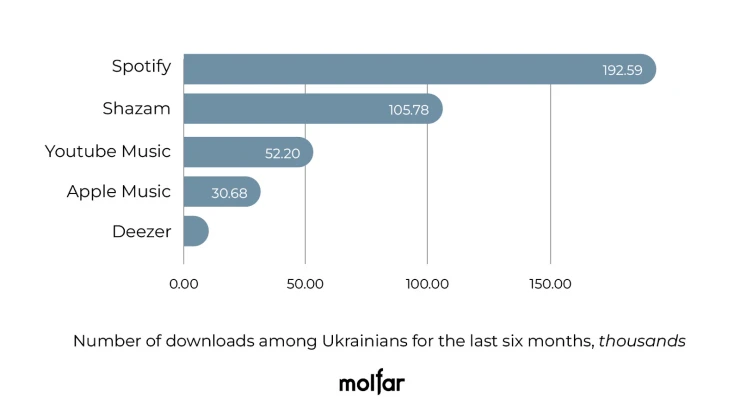For decades, Russia has pushed everything Ukrainian out of Ukrainian cultural space. She invested many rubles in it, and Ukrainians consumed Russian cinema, literature, music, because they had none of their own. And if Ukrainians began to give up on Russian cinema in 2014, the situation with music is more difficult until today. And social media contributes to this too: the list "popular" or "recommended" on YouTube or mass music trends on TikTok to the accompaniment of Russians Morningstern or Instasamka.
The OSINT-community Molfar researched the music content popular among Ukrainians and analyzed how their preferences have changed from the beginning of this year until today. They also found out on which music platform Ukrainians continue to listen to Russian songs.
Which music services are popular in Ukraine
YouTube Music, Spotify, Apple Music, Deezer, and Shazam are the most popular music platforms in Ukraine now. Shazam was added to this list because users can follow the charts there and listen to them on Apple Music.
According to data from the Sensor Tower service, over the past six months, 192.59k Ukrainians have installed Spotify — this service is the leader in the number of downloads. 52.20k new users joined YouTube Music, about 10k — on Deezer, 105.78k Ukrainians downloaded Shazam, and another 30.68k Ukrainians registered on the Apple Music service.

TOPs of music platforms in Ukraine: which part of Russian content there
Popular music charts demonstrate the general trend of music content consumption by Ukrainians. And even after February 24, not all music TOPs consist only of Ukrainian compositions.
We analyzed the TOP 100 songs of the music platforms, identifying the songs by the country represented by the artist. So, the largest number of Ukrainian content is on YouTube Music now — 76%, Deezer has 61% Ukrainian music content, and the least — Shazam and Spotify — 38%.
A lot of Russian music is represented in the charts of Spotify — 48% and Apple Music — 27% and — Shazam — 13%.

How the musical preferences of Ukrainians changed (on the example of the YouTube Music and Spotify charts)
Spoiler: the situation slowly began to change from February 24, but not as radically and quickly as it should be. So, what songs Ukrainians have been listening to since the beginning of the year? The dynamics in the YouTube Music and Spotify charts will show changes of preferences.
The TOP-10 songs popular among Ukrainians on Spotify and YouTube Music included only Russian compositions at the beginning of February. But the situation slowly began to change after the national selection for Eurovision — Ukrainian music was added to YouTube and Spotify with the legendary “Stefania” by the Kalush Orchestra and their song with artist Skofka hit — “Dodomu”.
Russia's full-scale invasion of Ukraine gave a strong impetus to abandon Russian music content. Ukrainians on YouTube Music began to listen to compositions corresponding to their moods: Okean Elzy — “Ne tvoya viyna”, (which means — “Not your war”), TikTok music-cover “Dobroho vechora, my z Ukrainy” (“Good evening, we are from Ukraine”), “Bandera - is our Father “,” I am a soldier”, “Marichka”, and others.
The situation in the first days after the invasion did not change much on Spotify: “Vova, %bash ikh” (“Vova, f*ck them”) and the song “Trymay” (“Hold me”) by Khrystyna Soloviy were added to the two songs of the Kalush band.

The situation in the music charts changed little by little with each terrible news about Russian terror. This is most noticeable in YouTube Music trends.
For example, after the news about the Russians’ cynical disruption of the evacuation of civilians in Irpin on March 5, there were 4 Russian songs in the chart on YouTube Music. There were at least 8 Russian songs in the TOP-10 on Spotify at the same time. After the terrorist attack in Kremenchuk, on June 26, there were no more Russian compositions in the rating on YouTube Music until now.
On the other hand, the Spotify charts were not affected by the news about terrible actions of the Russians in Bucha, Irpin and Mariupol, nor the terrorist attacks iin Kremenchuk or Vinnytsia — Russian compositions are still regularly present in the Ukrainian music TOPs on Spotify.
- How Top 100 charts were changing on YouTube Music (GIF)
- How Top 100 charts were changing on Spotify (GIF)
Every second song in the Ukrainian TOP of Spotify is a Russian
With the beginning of the full-scale invasion of Russia into Ukraine, Spotify suspended its activities in Russia. And, for example, the less popular Deezer has been offering free premium access to its current users in Ukraine since February 24. But in the long term, this actually did not affect the Spotify platform, which is the most popular among Ukrainian users now. However, the situation with Russian content on Ukrainian charts is the worst on Spotify. The rating leads a Russian song, and another 45 entered the TOP-100. Almost every second song from the Ukrainian chart is a Russian song.

So, are Ukrainians still listening to Russian music on Spotify? Or the artificial intelligence algorithms of Spotify, which was so praised for the personalized selection of new recommendations, turned out to be not so developed? Because they are pushing Russian content, counting on the fact that consumers of Ukrainian content might like it.
No one said that the rejection of Russian content would be radical, However, awareness of the dangers of consuming Russian culture has led to the gradual displacement of Ukrainians own content. It is not only about manipulation, promotion of Kremlin narratives, but also about money. After all, every listening to a Russian song is income, and as a result, Russian taxes, which turn into enemy missiles.
During the full-scale invasion of Russia, Ukrainians began to create their own content, varying in genres, themes, and quality. But this displacement of Russian culture is the first step towards the formation of one's own.
Molfar




